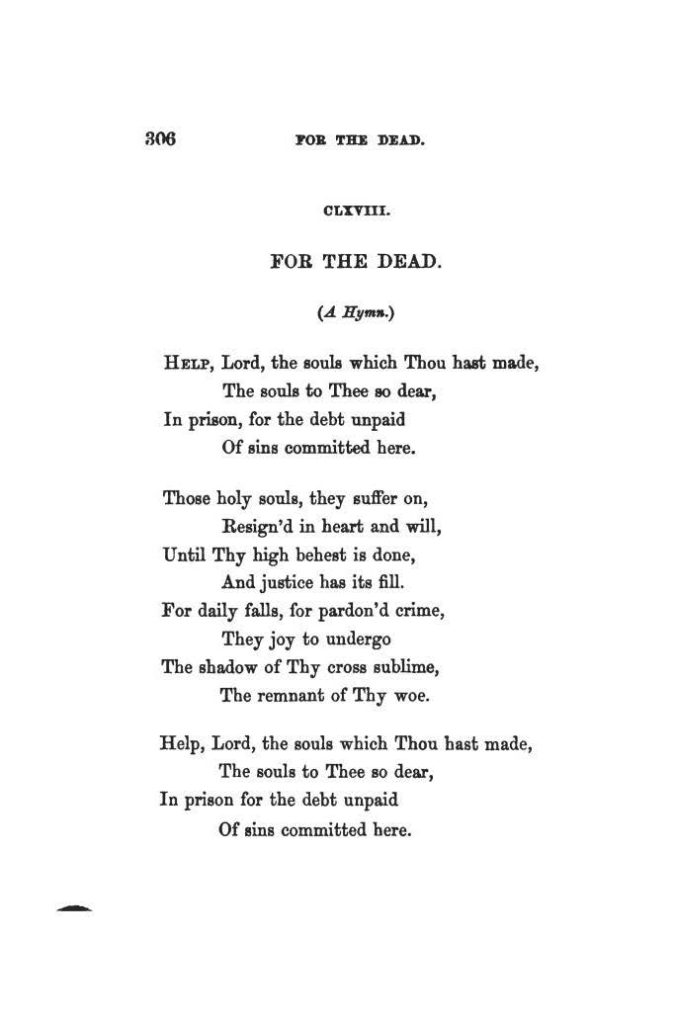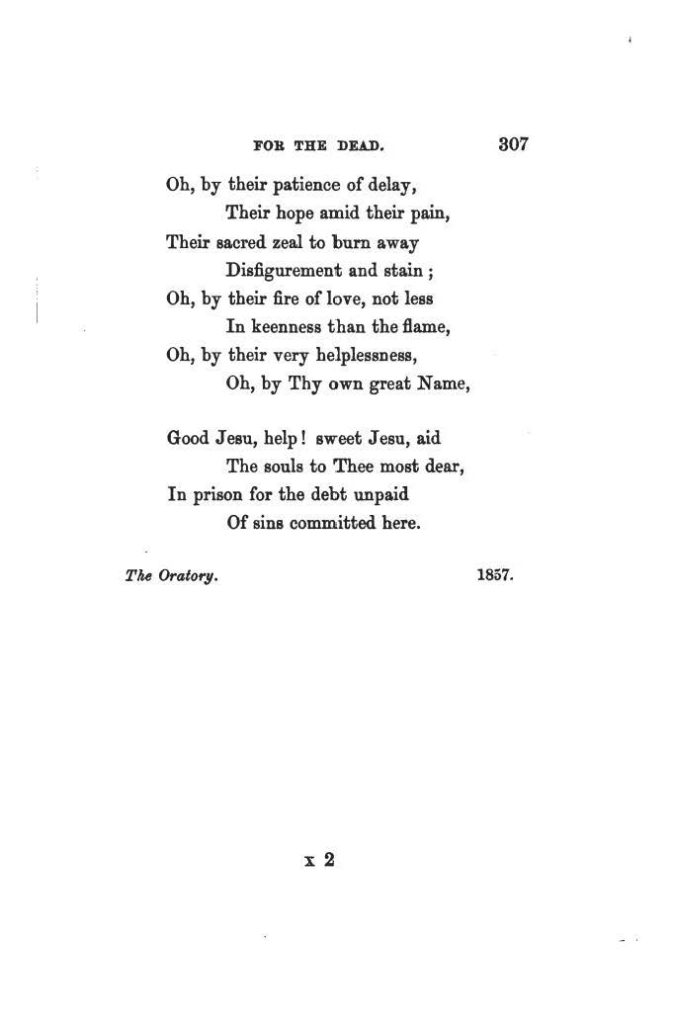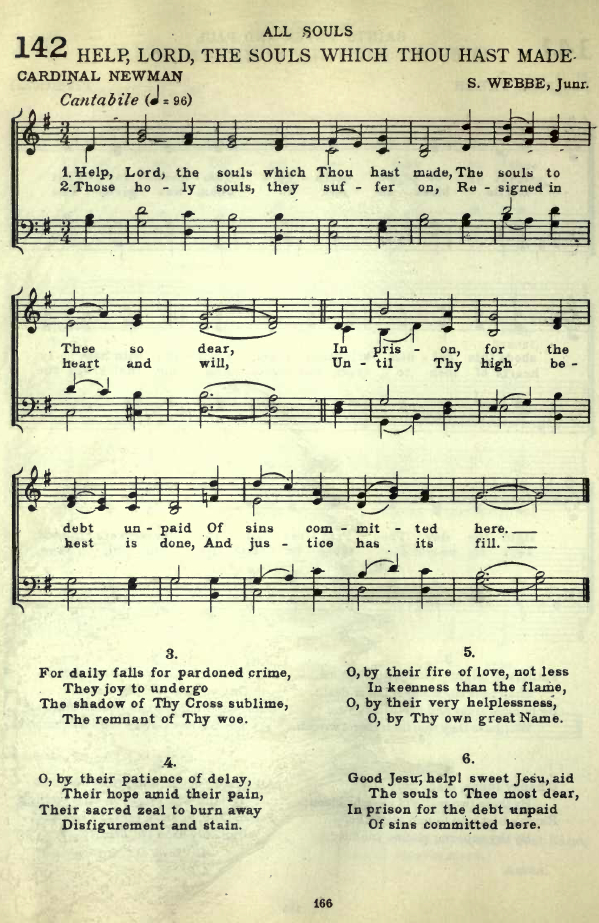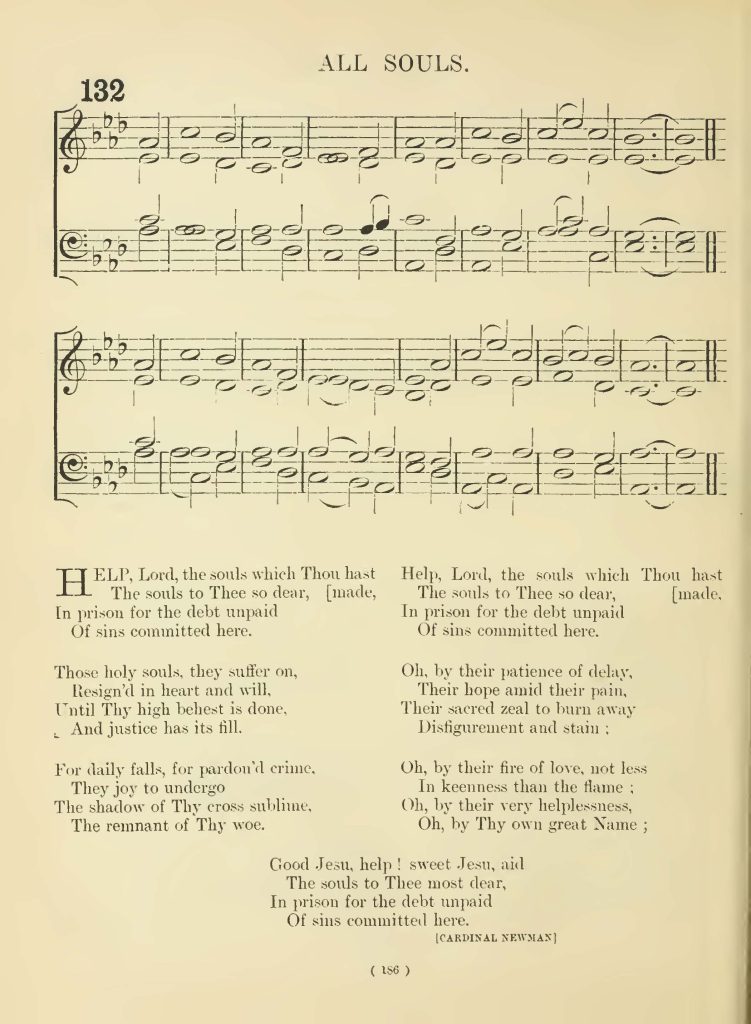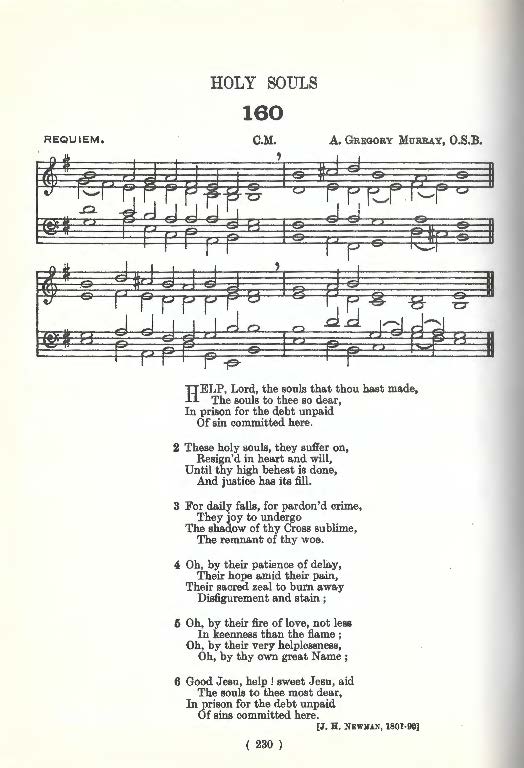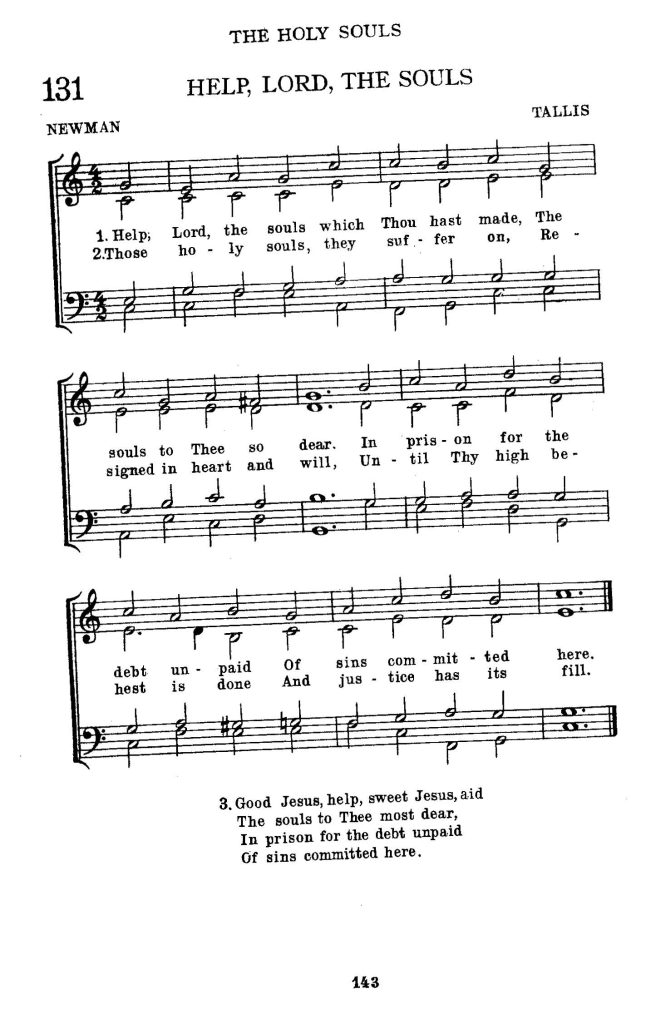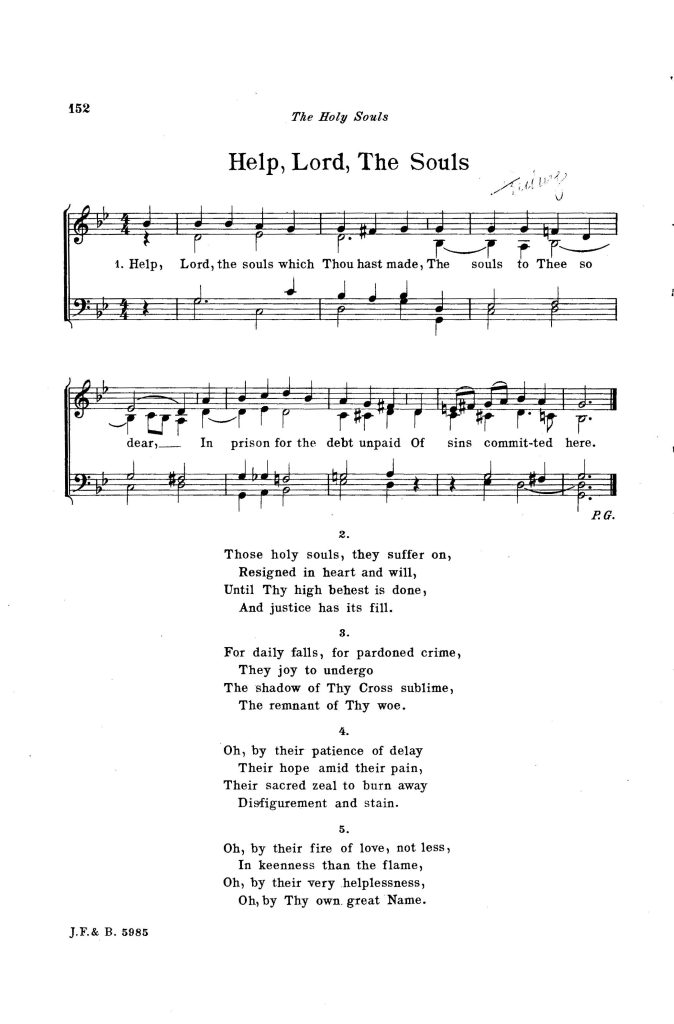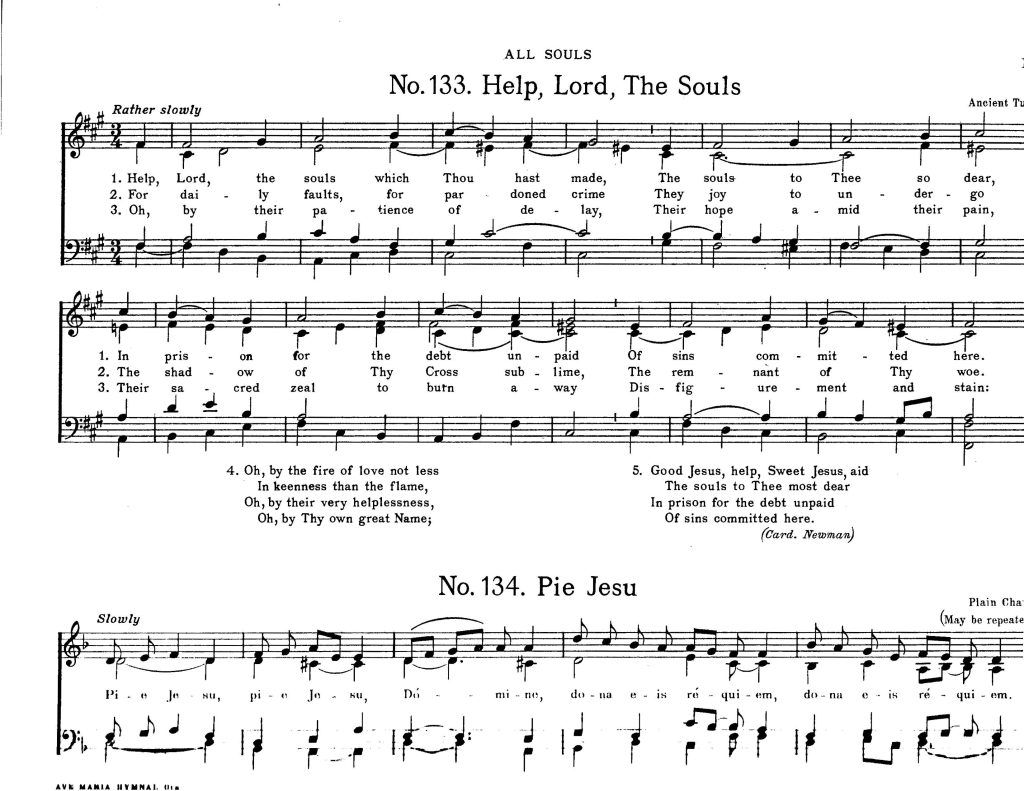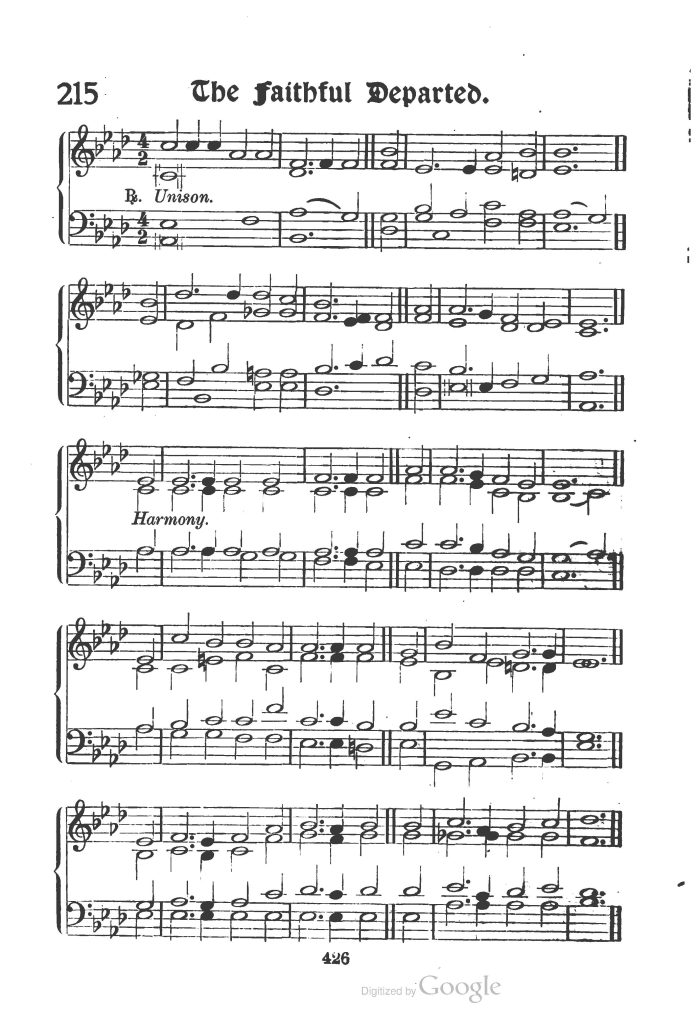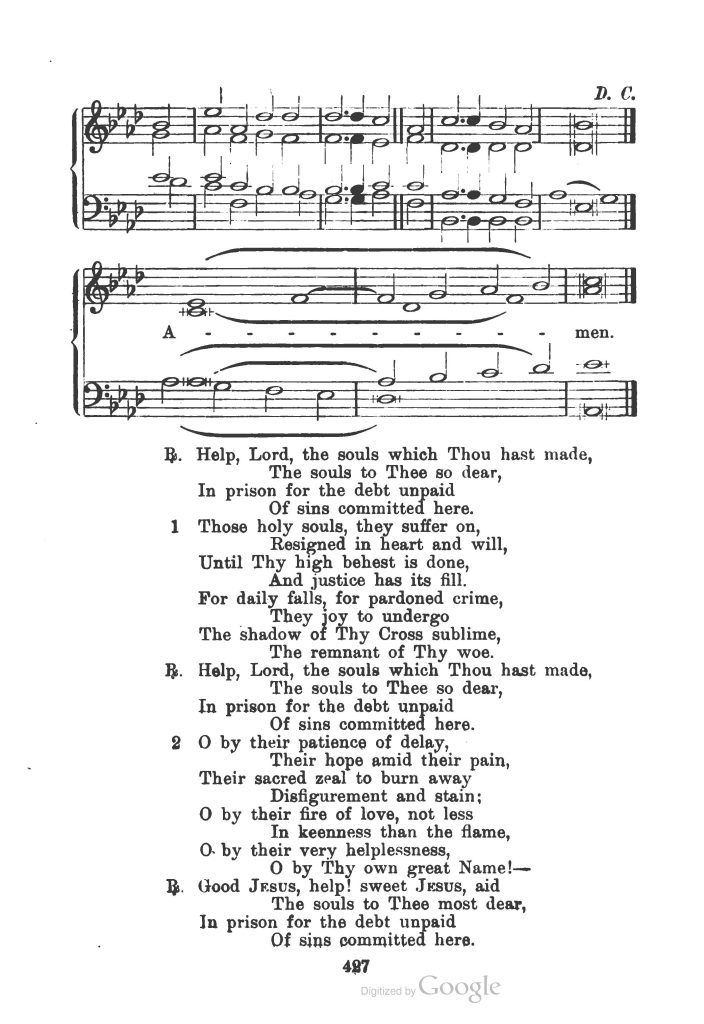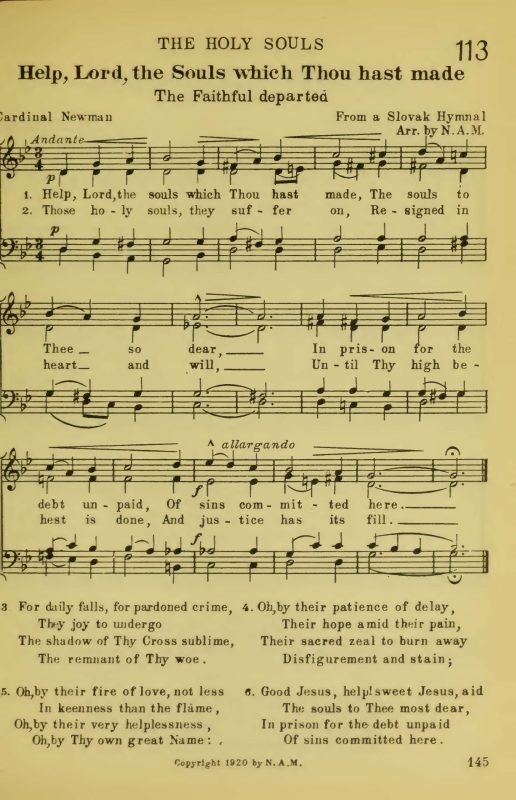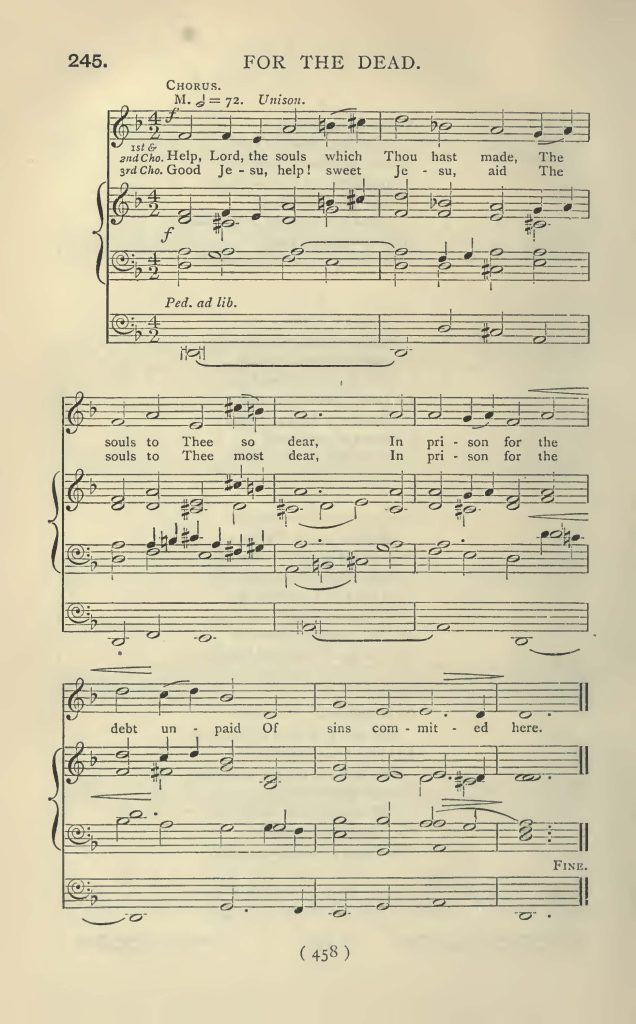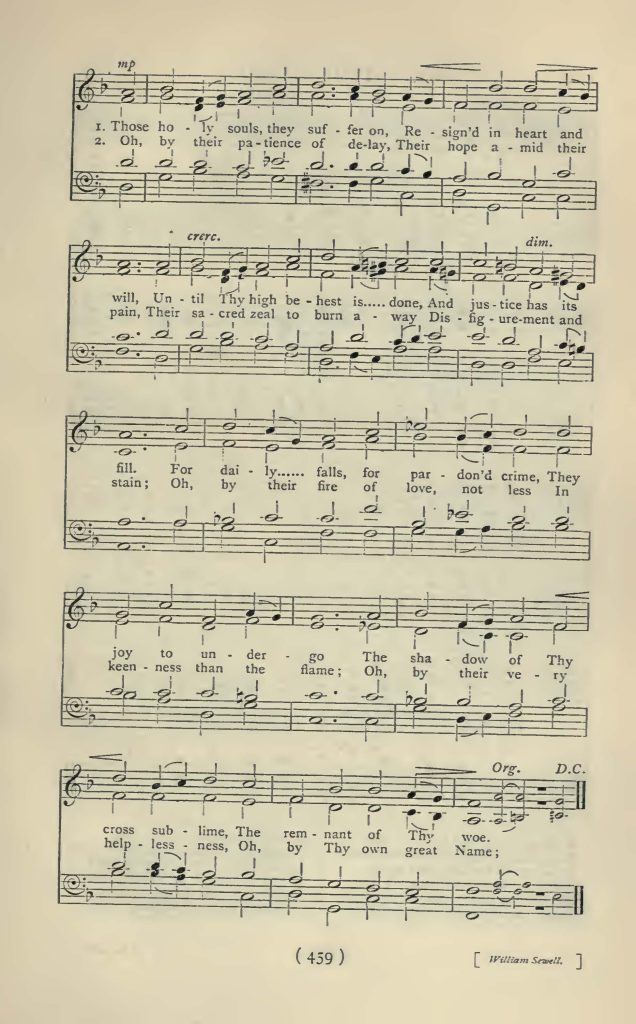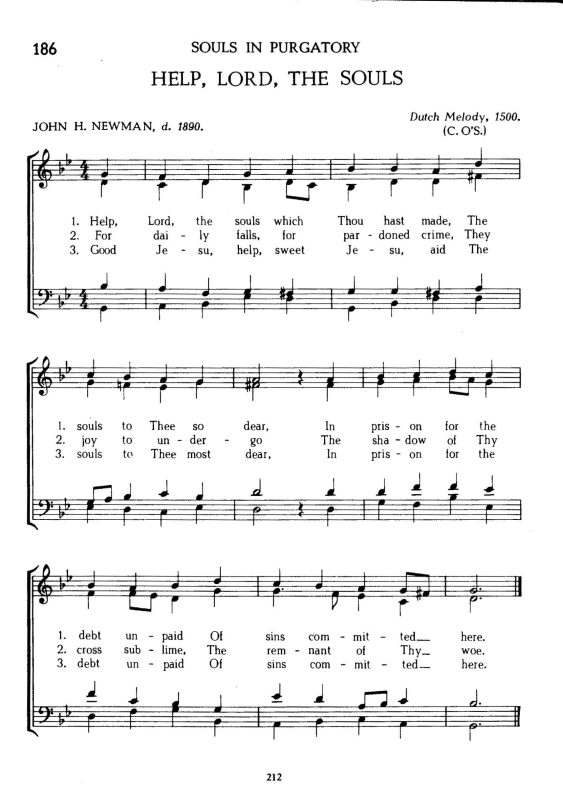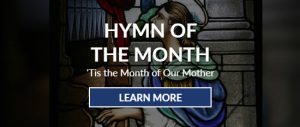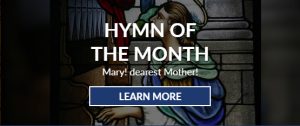The words of this hymn was written by Cardinal John Henry Newman, now Saint John Henry Newman. This hymn appears in his HYMNS AND VERSES, 1853, and later in his VERSES ON VARIOUS OCCASIONS, 1868, and captioned For the Dead (A Hymn) with a reference date, The Oratory, 1857.
There is so much that I could write about life of Saint John Henry Neman and his journey to Catholicism, but this would be a somewhat lengthy endeavor and is beyond the scope of this short write-up. However, it seems only fair to mention something of his journey to the Catholic Church.
John Henry Newman was born in February of 1801 in Old Broad Street, London, and in 1808 attended Ealing School. In the summer of 1817, he went into residence at Trinity College, one of the constituent colleges of Oxford University. He excelled in his education, taking a Bachelor of Arts, in 1820, and Master of Arts, in 1823. By the Spring of 1824, he was engaged to take the curacy of St. Clement’s at Oxford, and by June of the same year, he was ordained a deacon in the Church of England. The following year in late May of 1825, he was ordained a priest at Christ Church, Oxford, and in 1828, he was appointed by the Bishop of Oxford to the Vicarage of the University Church, St. Mary the Virgin.
On a historical note, Oxford University has been the center of three great religious movements, each associated with the name of a single man, the Lollardist, a pre-Protestant religious movement in the fourteenth century, the Methodist in the eighteenth, and the Oxford Movement in the nineteenth. The first, John Wycliffe was the inspiring genius; of the second, John Wesley; and of the third, John Henry Newman. The third of these movements, the Oxford Movement, carried John Henry Neman, together with many of his friends and followers, into the bosom of the Catholic Church.
In the years following his appointment as Vicar of St. Mary the Virgin, a number of parliamentary events would turn much of the established church and state traditions in on itself, including the repeal of the Corporation and Test Acts of 1828, the passing of the Catholic Emancipation Bill of 1829, and the Reform Bill of 1832. These events would challenge the teaching by Anglican theologians, that the State and the Church were constituted of the same body of men viewed under different aspects, the Church being the State in its spiritual, and the State being the Church in its temporal aspect. Among the clergy however, a more pressing question was at stake, especially for those who had accepted the High Church tradition, that is, if the Church were disestablished, on what foundation did their authority to teach the nation rest?
At the heart of the Oxford Movement was John Henry Newman and the Tracts for the Times, a religious pamphlet that was circulated throughout the English countryside. The most famous of these Tracts was Tract 90, published in 1841, where Newman scrupulously examined the thirty-nine articles that defined the doctrine of the Church of England. In his examinations, Newman contended that at its root the identity of the Church of England was Catholic rather than Protestant.
Almost at once, Newman was regarded as a traitor. Tract 90 was denounced by the Church of England as Newman knew it probably would be. Soon afterwards, a firestorm irrupted, many clergy, various ranks of nobility, military, medical and legal professionals, publishers, universities scholars and students, and other Protestants from every walk of life, converted to Catholicism. Newman maintained his position as Vicar of St. Mary the Virgin until 1843, when he was compelled to resign it. For two years, Newman would face many agonies until, by his own convictions, he left the Church of England.
By 1845, he had retired to the Oxford parish of Littlemore, and with the help of a Passionist priest, made his submission to the Catholic Church and within two years he was ordained a Catholic priest. He founded the English Oratory a year later. Then he was appointed Rector of the Catholic University of Ireland for four years and opened the Oratory School after that appointment. In 1877 he was elected the first honorary fellow of Trinity College and was made Cardinal in 1879 by Pope Leo XIII. He died on August 11, 1890, and was canonized by Pope Francis in 2019. Saint Newman was a prolific writer, and his published works are numerous.
The Hymnals
The hymn appeared in several Catholic hymnals. These include Tozer’s 1898 CATHOLIC HYMNS; the ARUNDEL HYMNS, 1905; Tozer’s CATHOLIC CHURCH HYMNAL, 1905 and 1933; the BOOK OF HYMNS WITH TUNES, 1913; MANUAL OF CATHOLIC HYMNS, 1916; the ST. BASIL’S HYMNAL from 1918 thru 1958; the ST. GREGORY HYMNAL, 1920 and 1940; the ST. MARY’S MANUAL, 1924; the SURSUM CORDA, 1925; also Cleveland, Ohio Bishop Schrembs’ DIOCESAN HYMNAL PART 2, 1928; the GLORIA HYMNAL, 1933; the AVE MARIA HYMNAL, 1936; the SAINT ANDREW HYMNAL, 1945; the WESTMINSTER HYMNAL, 1912, 1939, and 1952; the ST. CECILIA HYMNAL, 1955; and a couple of modern hymn books which include the ADORAMUS HYMNAL, 1997 and 2011; and A CATHOLIC BOOK OF HYMNS AND CHANTS, 2020.
The Melodies
From my own collection of over one-hundred-fifty hymnals that date from 1840 to 1992, I found several melodies that have been composed for this hymn. A quick survey on the internet suggest there may be other melodies that have been ascribed to this hymn. For example, the melody sometimes referred to as Coventry Carol (Lullah, thou little tiny child) from the 16th century works quite well. However, for the purpose of this short write-up I have limited the melodies to my own collection.
The melody by Samuel Webbe Jr., (1770-1843), and the melody by Dom Gregory Murray, O.S.B. (1905-1992) are the most common. There are a handful of lesser-known melodies which include compositions by Thomas Tallis (1505-1585), an English composer of Renaissance music; Thomas Haigh (1769-1806), and English composer and violinist; a Slovak melody arranged by Nicola Montani (1880-1948); a melody by Willam Sewell (1861-1942), the choirmaster and organist at the Birmingham Oratory; a melody arranged by Msgr. Peter Griesbacher (1864-1933); from the Ave Maria Hymnal is a melody named Ancient Melody; and a Dutch melody arranged by Cornelius O’Sullivan (1841-1907), a brewer’s chemist and self-taught musician, several of his hymn arrangements are found in the New Saint Basil Hymnal.
More than any other hymnal, the St. Basil’s was the most widely used hymnal in the United States and Canada. Because of the hymnals popularity, many hymns became beloved among Catholic choirs more so than the hymns original source. The hymnal was also the most severely criticized of all American hymnals.
The composer Samuel Webbe Jr. was born in London and studied music under his father and became a good pianist and organist. Following in his father’s footsteps, he devoted himself to the practice of vocal composition. Around 1817, he started teaching music and became the organist of the Spanish ambassador’s chapel. Many years afterwards he became the organist at St. Nicholas Church and St. Patrick’s Roman Catholic Chapel. He composed many songs, motets, and hymns. He died November 25, 1843.
Sir Richard Runciman Terry was the choirmaster of the Westminster Roman Catholic Cathedral in London. He is best known for cultivating a revival of English church music. He was the principal editor of the Westminster Hymnal published in 1912. This hymnal was the only authorized collection of hymns of the Catholic Church of England and Wales. The melody is listed simply as a Spanish Melody.
In the 1940 and 1952 editions of the Westminster Hymnal, the Spanish Melody was replaced with a melody by Dom Gregory Murray, O.S.B., M.A., F.R.C.O. He began his musical career as a choirboy under Sir Richard Terry at Westminster Cathedral, London. While still a boy he became assistant organist to Sir Richard. As organist and choirmaster of Downside Abbey he continued his active interest in all branches of church music, particularly Gregorian Chant. He passed the examination for Fellowship of the Royal College of Organists at the age of seventeen. He served on the Committee of the Society of St. Gregory, the English association of Catholic church musicians, and his organ recitals, for some time, were regular feature of English Radio programs.
The Gloria Hymnal was published by the Basilian Fathers in 1933. It is a hymnal for use in church, schools, and home with a collection of English and Latin hymns, Masses, Vespers, and Benediction motets. It contains liturgical music for requiems, funerals, Forty Hours, and other religious functions. It is remarkably similar to St. Basil’s hymnal though some of the hymns are different.
The composer Thomas Tallis was an English composer of sacred music and was a leading figure in church music in the 16th century. In 1575, he and William Byrd were granted a patent to print and publish music. This was the first time such a patent had been granted. He is probably best known for his choral piece If Ye Love Me. Thomas Tallis died in November 1585.
The Diocesan Hymnal Part 2 was compiled by Cleveland, Ohio Bishop Joseph Schrembs, and it was published in 1928. He compiled and published three hymnals including, The Diocesan Hymnal Part 1 which was published in 1926 consisting of Communion and Confirmation Hymns. Part 2 consisting of Devotional Hymns, and a third, The Eucharistic Hymnal published in 1935, embodied hymns taken from Part 1 & Part 2. He was himself a musician and composed several hymns and was instrumental in producing manuals of Gregorian Chant and Catholic editions of music text books for elementary schools. He is also considered one of the pioneers of Catholic radio. He spoke frequently on local radio stations giving sermons and catechetical instructions often followed by the singing of hymns for which he composed the tunes. He was instrumental in persuading the National Council of Catholic Men (NCCM) to sponsor the Catholic Hour that began broadcasting in 1930. This weekly radio program reached a large national audience.
Monsignor Peter Griesbacher was responsible for a large number of harmonization’s of the hymns found in the Diocesan Hymnals. He was German born and ordained a priest in 1886. He edited a number of publications of Catholic church music and has composed numerous mass settings, a number of cantatas, various choral works, and organ manuals. He died on January 28, 1933.
The Ave Maria Hymnal was compiled by Father Joseph J. Pierron and published by The Bruce Publishing Company with offices in New York, Milwaukee, and Chicago. The Ave Maria Hymnal saw several editions with the first edition published in 1929 and the last edition in 1941.
The Ave Maria Hymnal is a collection of English and older German melodies. Father Joseph Pierron was ordained a priest in 1905 and studied music in Europe for three years. He held assistant positions in various parishes and pastorship in several prominent churches throughout Wisconsin. In November 1949, he went to Boys Town, Nebraska to serve as music director for Father Flanagan’s boys. Father Pierron was editor of the Caecilia magazine in 1930, and composed several hymns, hymn collections, mass settings, and authored several articles on music.
The Book of Hymns with Tunes was compiled by Dom Samuel Ould, O.S.B., and was published in 1913. It is one of the most important Scottish Catholic hymnals of the day. Dom Samuel Ould was a member of the Benedictine Community, Fort Augustus Abbey, Iverness, Scotland. He was the son of Wesleyan Methodist parents; he was received into the Roman Catholic Church in 1879 and became a priest in 1891. He was an organist, composer, a writer of Ecclesiastical music, and a noted hymnologist. He is best known for being the first musician to give the full eight stanzas of the Adeste fideles and provide a harmonization for each of them.
The composer was Thomas Haigh, he was an English violinist, and pianist. He studied music composition under Joseph Haydn in the early 1790s. He also studied organ at the Royal College of Music in London and made several trips to Australia where he was for a time organist and choirmaster at St. Andrews Cathedral in Sydney. He wrote orchestral, chamber, church, and piano music. He died in London in April 1808.
The St. Gregory Hymnal and Choir Book was compiled by Nicola A. Montani and published in 1920 and a revised edition in 1940. He was a conductor, composer, arranger, and publisher of sacred music. He was the cofounder of the St. Gregory Guild and the Society of St. Gregory. He was chief editor of the Catholic Choirmaster, a monthly magazine devoted to liturgical church music.
The melody is from the Slovak hymnal identified by J. Vincent Higginson, author of Handbook for American Catholic Hymnals as Duchovny Spevnik Katolicky published in 1909.
The Arundel Hymnal was compiled and edited by Henry Duke of Norfolk and Charles T. Gatty, Fellow of the Society of Antiquities. The hymnal is a tribute to Saint Philip Howard, Lord Arundel, born in 1557 who died in the Tower of London, 1595, for his religious beliefs. He was canonized by Pope Paul VI in 1970. The Arundel hymnal was originally produced in parts and when the first part was completed in 1898, Henry Duke of Norfolk sent a copy to Pope Leo XIII who in turn wrote a letter of congratulations and encouragement. The Arundel hymnal is a collection of German, Italian, Spanish, Portuguese, Bohemian, and Hungarian tunes and texts. The Arundel Hymnal could be characterized as an anthology given the wide diversity of texts and tunes and as such became a source for American editors in search of new material.
The composer of this melody was William Sewell. He served as the organist of the Redemptorist Church of St. Mary’s, Clapham for twenty-five years. He composed a Mass setting for St. Philip Neri while he was in charge of music at Birmingham Oratory as well as other Mass settings. He was co-editor of THE BOOK OF HYMNS WITH TUNES in collaboration with Dom Gregory Ould. William was a convert to Catholicism and joined the Church of Rome in 1885.
Last but not least we have a melody found in the New Saint Basil Hymnal. This hymnal was the last of the St. Basil’s hymnals and was published shortly after the Encyclical Mediator Dei of 1947 and the Encyclical Musica Sacra Disciplinae of 1955. The Encyclical Mediator Dei stressed the importance of having the congregation answer the priest in a fitting manner or sing hymns suitable to the parts of the Mass. The Encyclical Musica Sacra Disciplinae expressed similar ideas, enlarging the principles concerning hymnody and made other suggestions.
In the Preface of the New Saint Basil Hymnal, the editors explained that the focus of the hymnal was toward congregational participation and liturgical song. They further commented on the good old hymns, those hymns beloved by Catholics for more than half a century if not longer, were outdated and harmful in that they expressed a religious emotion which was overly exaggerated, over familiar and, eventually, false – since they teach the singer to pray badly.
The new hymnal consisted largely of tunes from English, German, Irish, Italian, and Slavic sources. The hymnal was praised by some as one of the better outstanding contemporary collections that addressed the recent developments in American Catholic Hymnody. This praise was short lived and faded as the introduction of the vernacular liturgy became common place. In fact during the 1960s, 90% of the hymns in Catholic hymnals, those beloved by Catholics, were replaced by Protestant sources.
This 14th century Dutch melody was arranged by Cornelius O’Sullivan, a brewer’s chemist. Many of his arrangements can be found in the New Saint Basil Hymnal. Very little information on this self-taught musician exist. One source online, a Dictionary of Irish Biographies, gives the following: On Candlemas Day 1870, O’Sullivan married Edithe Nadin of Barrow Hall, Barrow upon Trent, near Derby, the daughter of a colliery owner. She was an accomplished musician and had a fine voice. The two became valued members of the choir at the local catholic chapel at Guild Street, Burton upon Trent. He died in January, 1907.
Reflection
We are often remiss in singing prayerful hymns for the poor souls in purgatory and asking God to pardon their sins committed here. The verses that Cardinal Newman wrote help me to remember the Church teachings on purgatory (CCC 1030-32), and that the souls there, joy to undergo the cleansing flames that they may be made perfect in heart and will, a reference to Matthew’s gospel 5:48, In a word you must be made perfect as your heavenly father is perfect. In the second verse, Until the high behest is done, And justice has its fill, I recall Matthew’s gospel, 5:26, I warn you; you will not be released until you have paid the last penny. I can also see this gospel passage in the fourth verse, In prison for the debt unpaid.
Both St. Peter and St. Paul, remind us of the cleansing flames (1 Cor.3:15; 1 Peter 1:7). Anyone who meditates on these verses will see something different or recall some passage from the Old or New Testament or nothing at all.
What can you see?
This is wonderful hymn to sing for All Souls Day and throughout the month of November, and really throughout the whole year. This hymn reminds me of our duty to pray for our loved ones, our friends who are gone now, and our neighbors.
May we always remember our departed loved ones by singing prayerful hymns and may those who hear this hymn especially those in most need of God’s mercy be given pardon and granted everlasting life.
Below are computer generated sound files of all the melodies listed above. The tempo is approximate but should provide those listening a good sense of what the hymn sounds like. Of all the melodies listed below, I like the Spanish melody from the Westminster Hymnal, 1912.

